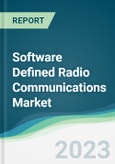The Software Defined Radio Communications Market Study offers a comprehensive analysis of the global software-defined radio (SDR) communications market, providing industry experts with critical insights into market trends, technological advancements, and competitive strategies. This study explores the pivotal role of SDR in enabling flexible and efficient communication systems across military, telecommunications, and space applications. By examining key market drivers, restraints, and competitive developments, the Software Defined Radio Communications Market Study equips stakeholders in defense, telecom, and aerospace sectors with actionable intelligence to navigate this rapidly evolving market.
Study Overview
The Software Defined Radio Communications Market Study delivers an in-depth examination of the SDR market, segmented by technology (adaptive radio, cognitive/intelligent radio, and joint tactical radio system), components (hardware, software, and services), and applications (military, telecommunications, space communication, and others). The study analyzes market drivers, such as the increasing demand for interoperable communication systems in defense, alongside restraints like high development costs and cybersecurity concerns. It includes Porter’s Five Forces Analysis, industry value chain insights, and strategic recommendations, with regional breakdowns covering North America, South America, Europe, Middle East and Africa, and Asia Pacific, highlighting growth opportunities in key markets like the USA and China.Competitive Environment and Analysis
In the Software Defined Radio Communications Market Study, the competitive environment section highlights strategic innovations from key players shaping the market. Recent developments from leading companies underscore the industry’s focus on advanced technology and interoperability:L3Harris Technologies, Inc.: In 2024, L3Harris launched an advanced SDR platform with enhanced waveform flexibility, improving secure communication efficiency by 25% for military applications. This development strengthens L3Harris’ position in the defense sector, addressing the need for robust, multi-band communication systems in complex operational environments.
Thales: In early 2025, Thales introduced a next-generation cognitive radio system with AI-driven spectrum management, optimizing bandwidth utilization for telecommunications and space communication applications. This innovation reinforces Thales’ leadership in delivering adaptive and intelligent SDR solutions for diverse use cases.
The Software Defined Radio Communications Market Study also includes a market share analysis, detailing mergers, acquisitions, and collaborations, such as Raytheon Technologies Corporation’s 2024 partnership with a leading satellite communication provider to integrate SDR solutions for enhanced space connectivity. The competitive dashboard provides a clear view of these dynamics, enabling industry experts to assess market positioning and strategic trends.
Conclusion
The Software Defined Radio Communications Market Study is an essential resource for industry experts seeking to understand the competitive and technological landscape of the SDR communications market. By spotlighting key developments from players like L3Harris and Thales, alongside comprehensive segmentation and regional insights, this study empowers stakeholders to make informed strategic decisions. As SDR technology continues to drive innovation in military and telecommunications applications, the Software Defined Radio Communications Market Study offers a strategic guide for capitalizing on opportunities in this dynamic market.Key Benefits of this Report:
- Insightful Analysis: Gain detailed market insights covering major as well as emerging geographical regions, focusing on customer segments, government policies and socio-economic factors, consumer preferences, industry verticals, and other sub-segments.
- Competitive Landscape: Understand the strategic maneuvers employed by key players globally to understand possible market penetration with the correct strategy.
- Market Drivers & Future Trends: Explore the dynamic factors and pivotal market trends and how they will shape future market developments.
- Actionable Recommendations: Utilize the insights to exercise strategic decisions to uncover new business streams and revenues in a dynamic environment.
- Caters to a Wide Audience: Beneficial and cost-effective for startups, research institutions, consultants, SMEs, and large enterprises.
What do businesses use our reports for?
Industry and Market Insights, Opportunity Assessment, Product Demand Forecasting, Market Entry Strategy, Geographical Expansion, Capital Investment Decisions, Regulatory Framework & Implications, New Product Development, Competitive IntelligenceReport Coverage:
- Historical data from 2022 to 2024 & forecast data from 2025 to 2030
- Growth Opportunities, Challenges, Supply Chain Outlook, Regulatory Framework, and Trend Analysis
- Competitive Positioning, Strategies, and Market Share Analysis
- Revenue Growth and Forecast Assessment of segments and regions including countries
- Company Profiling (Strategies, Products, Financial Information, and Key Developments among others).
Software Defined Radio Communications Market Segmentation:
By Technology
- Adaptive Radio
- Cognitive/ Intelligent Radio
- Joint Tactical Radio System
By Component
- Hardware
- RF Receiver/Transmitter
- Amplifier
- Others
- Software
- Services
By Application
- Military Applications
- Telecommunications
- Space Communication
- Others
By Geography
- North America
- United States
- Canada
- Mexico
- South America
- Brazil
- Argentina
- Others
- Europe
- United Kingdom
- Germany
- France
- Spain
- Others
- Middle East and Africa
- Saudi Arabia
- UAE
- Israel
- Others
- Asia Pacific
- Japan
- China
- India
- South Korea
- Indonesia
- Thailand
- Others
Table of Contents
Companies Mentioned
- Northrop Grumman Corporation
- Thales
- Elbit Systems Ltd.
- Raytheon Technologies Corporation
- L3Harris Technologies, Inc
- BAE Systems
- Leonardo S.p.A.
- Rohde & Schwarz GmbH & Co KG
- Viasat, Inc.
- Analog Devices Inc.
- Aselsan A.S.
Table Information
| Report Attribute | Details |
|---|---|
| No. of Pages | 145 |
| Published | July 2025 |
| Forecast Period | 2025 - 2030 |
| Estimated Market Value ( USD | $ 15.64 Billion |
| Forecasted Market Value ( USD | $ 21.86 Billion |
| Compound Annual Growth Rate | 6.9% |
| Regions Covered | Global |
| No. of Companies Mentioned | 11 |









